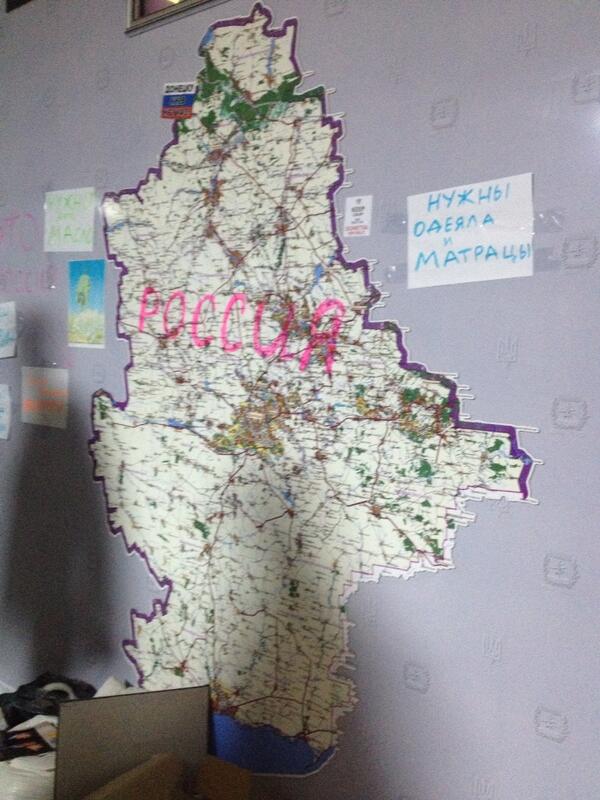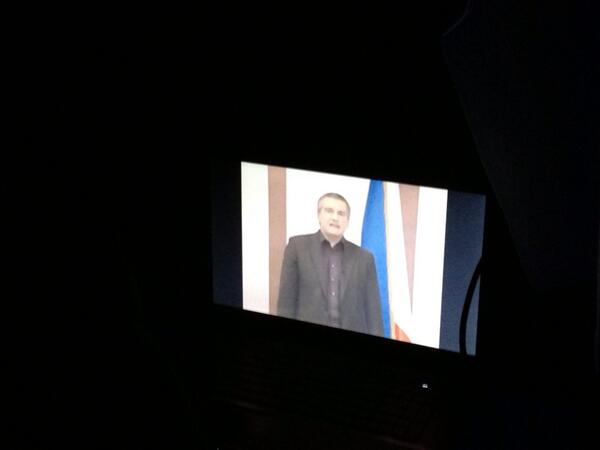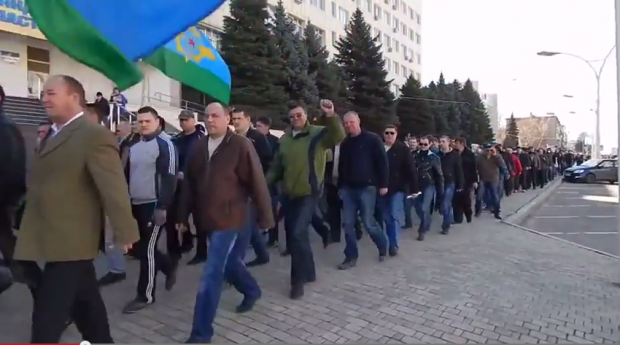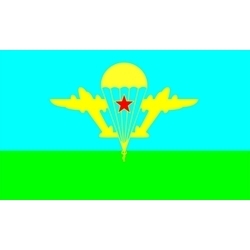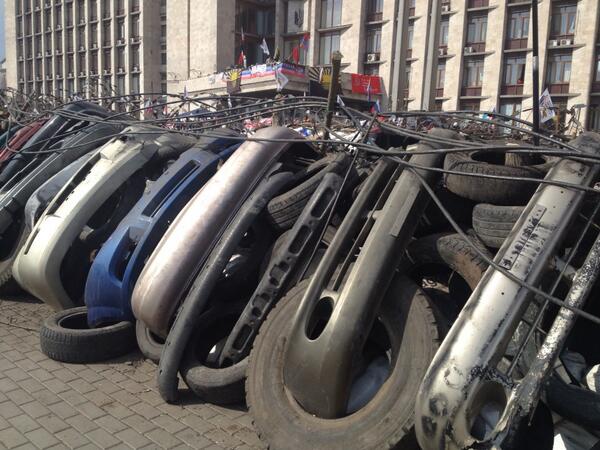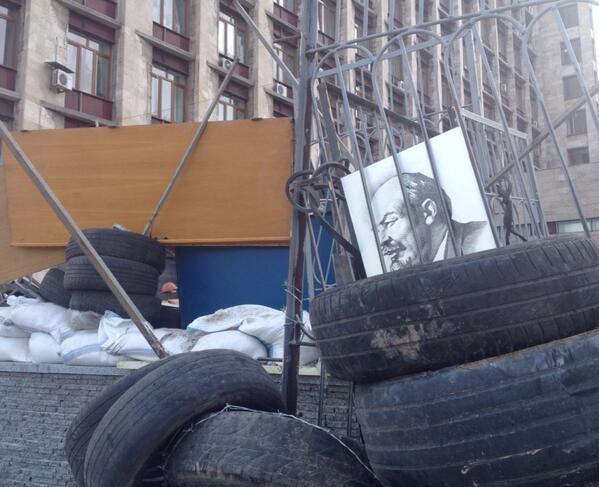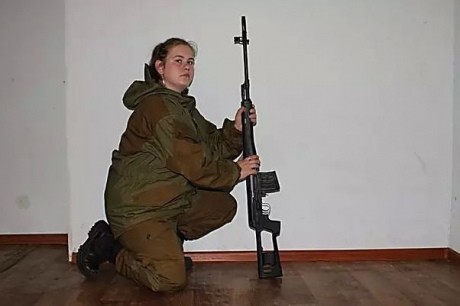Ukraine’s Interior Minister has given pro-Russian separatists who have taken over government buildings 48 hours to negotiate with authorities or they will be removed by force.
Yesterday’s liveblog can be found here. For an overview and analysis of this developing story see our latest podcast.
Please help The Interpreter to continue providing this valuable information service by making a donation towards our costs.
An interactive map of the situation:
View Ukraine: April 9, 2014 in a larger map
Below we will be making regular updates. Be sure to check back often and hit refresh.
1943 GMT: Echoing what we’ve been reporting, the US Ambassador to Ukraine says that pro-Russian separatism is not a widespread movement in eastern Ukraine:
"The call for separatism is not finding traction among the people in eastern Ukraine," says US ambassador @GeoffPyatt http://t.co/f0ZVNAPDbC
— BBC World Service (@bbcworldservice) April 9, 2014
Don’t tell that to the separatists who are still holding several government buildings:
In the foyer of #Donetsk admin bldg, a change to the map on the wall. Someone has renamed Donetsk Region 'Russia' pic.twitter.com/Gp0T8a7pV0
— Steve Rosenberg (@BBCSteveR) April 9, 2014
Also, the protesters outside of the occupied buildings disagree with the polling data and the ambassador’s statements:
Donetsk protestors chant "Republic!" Then "We stand w/Russia." For them, independence is just a further point on Kiev-Moscow continuum
— Alec Luhn (@ASLuhn) April 9, 2014
Somebody has set up a mock Russian border sign in square in front of Donetsk occupation. People photographing their kids next to it
— Alec Luhn (@ASLuhn) April 9, 2014
I just got kicked out of pro-Russian Luhansk occupation for asking too many questions. Rarely have I seen such rabid anti-American sentiment
— Alec Luhn (@ASLuhn) April 9, 2014
1812 GMT: Sergey Aksyonov, the pro-Russian politician who is effectively the Prime Minister of Crimea after Russia’s annexation of the peninsula, is addressing pro-Russian crowds in Donetsk:
Sergei Aksyonov addressing Donetsk crowd by video link. pic.twitter.com/rdA29NItgD
— Roland Oliphant (@RolandOliphant) April 9, 2014
1702 GMT: RT, the Kremlin-run TV channel, whose propaganda, disinformation, and range of ‘expert’ guests including neo-Nazis and 9/11 deniers, has been under scrutiny by The Interpreter for a while now, has invited our editor-in-chief Michael Weiss to appear on its program CrossTalk. He has politely declined:
Dear Mr Weiss,
I am writing on behalf of Russia Today TV – 24/7 English language news station in Moscow broadcasting internationally.
My name is Mary, I am a producer of a panel discussion program called CrossTalk.
I have the honor to invite you to our program.
We’re recording it Thursday, April 10, at 10:15 a.m. (Eastern time).
We can arrange a studio in any major city in the world.
We’ll be talking about Ukraine.
It goes without saying that we’ll be delighted to have you on the program!
Sincerely,
Maria Tokmakova
Producer
CrossTalk
Our editor-in-chief’s reply:
Thank you, Maria. I have the honor of informing you that I only appear on news channels and therefore cannot accept your kind invitation.
That said, I don’t want to leave you completely in the lurch. I ran into a homeless man on my way home from work yesterday who had some very interesting things to shout about Jewish bankers, the Illuminati, and also passing cars. I’d be glad to facilitate an introduction for you to have him on RT to discuss ongoing developments in Ukraine.Best wishes,
Michael Weiss
1649 GMT: Donetsk TV station ATN has been attacked by pro-Russian activists. Here is a summary of their report on the incident:
About 50 masked men broke into the offices of Kharkiv TV station ATN on 7 April, after most of the employees had already left for the day. They told those who remained not to make any phone calls. The group was led by an anti-Maidan activist and live-stream reporter Sergei Yudayev and pro-Russian blogger Andrei Borodavka. The police were summoned, but didn’t come up to the 9th floor where the office was under attack. The pro-Russian group told the ATN employees to stop filming and that they were “fired”. When asked “by whom,” they said, “The people of Kharkiv.” They then grabbed a company cell phone to use.
The group demanded access to live broadcasting, but when it was explained to them that city authorities had not permitted ATN to have any live broadcasting for more than three years, they methodically broke all the computers and equipments, including the hard drives and control panels. When police finally questioned their actions, they told them to leave the building.
The video posted to atn.ua shows how the raiders reached the general director’s office and then debated whether to steal the money found there and forced the director to write a resignation letter. Eventually they returned the cash and the phone — after first extracting the SIM card.
Oleg Yukht, general director of ATN, said that the regional prosecutor is investigating the raid, under the oversight of the Kiev prosecutor general’s office.
Eyewitnesses reported that the raiders and the police seemed to know each other, and police appeared inactive until finally responding to journalists’ pleas. Police chief Anatoly Dmitriev of the Kharkiv Region Interior Ministry said that they had sent officers to the scene, that 40 people were made to leave the building, and they were in the process of identifying them. ATN was not sure when they could get back on the air, as the damage was extensive, but will continue providing reports at atn.ua
Here is a video of the incident:
1643 GMT: From our Russia This Week blog:
There’s been a lot of speculation about the provenance of the well-organized instigators of violence in Ukraine’s south-east, and whether they are paid by the Russian government or occur spontaneously. White House spokesman Jay Carney spoke about the paid agitators yesterday and this is taken for granted by many observers because of a long-established pattern of Russian intelligence manipulation of civic groups in this region. Buses of demonstrators with clearly-marked Russian Federation license-plates and Russians speaking with the accents of cities in Russia have been clearly sighted in previous weeks, and some agency has to be covering their travel, food and lodging expenses. Journalists also report demonstrators who seem unfamiliar with the localities where they are protesting.
But some of the protesters themselves have denied to journalists that they are paid, and there’s no doubt that the sentiments in the eastern part of Ukraine are authentic. There’s also no question there are forces in Russia stirring up trouble.
In an interview with Buzzfeed’s Mike Giglio published yesterday, Andrei Porgin, a leader of a pro-Russian activist organization called “Donetsk Republic” described the movement in Donetsk as spontaneous and driven by the failure of the Kiev government:
“But he admitted to some Russian influence over the referendum push, saying he had received ‘intellectual’ support from ‘civil’ contacts inside Russia that he had developed over more than a decade as an activist. ‘Intellectual help I do receive,’ he said. ‘I speak on Skype with [Russian] political scientists and experts. I receive advice. That is all.’
The advice, he said, had included help with drafting the political statements surrounding the push for a referendum and guidelines on how to carry the process out. ‘We speak at the moment about international law,’ he said.
There had also been assistance from Russian “civil society” groups, he said, ‘in terms of social networks that helped to assemble some of the young [local] activists here.’
He added: ‘More than this they can not do.'”
That’s already quite a lot, however, and given that the Russian government has spent millions funding nationalist youth groups and supporting nationalists in office in Russia, it’s not trivial. Alexander Dugin, the Russian ultra-nationalist had a call for violent uprising on his Facebook (where he has more than 11,000 followers) after observing Ukrainian law-enforcement put down protests yesterday:
“We view these actions as a military annexation against the people of the Donetsk People’s Republic and call on all our supporters and militia to come to the assembly place at the National Council building for a general mobilization and readiness to defend our positions. EVERYONE TO THE NATIONAL COUNCIL BUILDING! EVERYONE TO THE DEFENSE OF THE DONETSK NATIONAL REPUBLIC!”
Dugin attached to it the game screenshot below and a post from Pavel Gubarev, a Donetsk activist, who warned this morning that Ukrainian tanks were nearing Donetsk and that reportedly civilians trying to block them had “suffered heavy losses.”
1628 GMT: Segodnya.ua reports on pro-Russian activists in Odessa:
Antimaidan activists are building barricades in Odessa. Protesters began to build fortifications on Kulikovo field last night. Clearly, they’re afraid of a repeat of past events in Mykolaiv, where local activists from Right Sector and Maidan Self-Defence dispersed pro-Russian protesters. Then, Antimaidan activists were driven away from the Mykolaiv Regional Administration to their usual gathering place, the monument to the Olshansky Heroes, but their tent city was then trashed.
“Today, reports were received from several sources that buses carrying members of Right Sector have left Mykolaiv for Odessa. The day before, they took part in the removal of the tent city. April 8-10 will be extremely tense, please be vigilant and be prepared to come to our aid”, reported Antimaidan coordinators on social networks.
Meanwhile, there was a post on the Odessa branch of Right Sector’s social network page calling for the dispersal of the pro-Russian rally in Odessa.
“There is no place for tents on Kulikovo. It’s time for a subbotnik. If the authorities do not remove the separatists’ nest, then the Maidan must do it”, writes Right Sector.
Messages are appearing on social network pages for Odessa Antimaidan activists, urging protesters to bring anything that can be used to reinforce Kulikovo Field. Protesters are now erecting barricades of tyres, sandbags and wooden planks.
Here is a photo tweeted earlier of some of the barricades:
Сегодня ночью возле Кулекового поля (палаточный городок Антимайдана) выгружали мешки с песком. Вот результат.
#одесса pic.twitter.com/CFBl5xk67J
— Yasya (@yyasyaa) April 9, 2014
1622 GMT: Journalist David Patrikarakos has tweeted a photo of Ukrainian heavy artillery on the move near Donetsk:
Heavy artilleryoutside #Donetsk!! Police supervising. Ukraine forces going to remove protestors by force? #Ukraine pic.twitter.com/qM6hkO9BuB
— David Patrikarakos (@dpatrikarakos) April 9, 2014
Obviously these assets would not be deployed against separatists within Donetsk, but are preparations to counter a military invasion.
1555 GMT: RFE/RL has a report, filmed yesterday, on a pro-Russian rally in Donetsk, outside the occupied regional administration building:
1544 GMT: Yesterday US’s ambassador to the OSCE stated that the size and scope of Russian military operations near the border with Ukraine showed that this was either an invasion or an intimidation force. Today, Russia has reiterated that the troops are only engaged in drills:
Russia’s Foreign Ministry said Wednesday that Ukraine and the United States have “no reason for concern” about the presence of Russian forces, which it says are on military exercises.
“Russia has repeatedly stated that it does not conduct unusual or unplanned activities which are militarily significant on its territory near the border with Ukraine,” the Foreign Ministry said in a prepared statement.
It added that accusations that Russia was building up its armed forces were “groundless.”
1522 GMT: A small crowd of pro-Russian demonstrators, waving the flag of the Russian Airborne Troops and the flag of the Soviet Airborne (not a Ukrainian flag as is claimed by some on the Open Newsroom), chant “Berkut, Berkut!” in support of the infamous riot police that were disbanded after the Yanukovych government fell. The video is titled “Gathering of Militia to the SBU,” a reference to the security services building which is occupied by pro-Russian separatists, and was reportedly taken in Lugansk today.
Note, the flag with the red star is actually a VDV Spetsnaz flag, one that appears to have been mostly used during World War II.
1455 GMT: What is really going on in Donetsk? The fact is that many who have visited the eastern Ukrainian city don’t see it as a city on the edge of revolution, but see a populace that is generally disinterested in the events that threaten to change it forever. NPR’s Ari Shapiro reports:
The occupied government building in the center of town is surrounded by razor wire and sandbags. It feels like the kind of place where nothing will happen unless, suddenly, something dramatic does.
Young men wearing face masks spend all day walking back and forth, carrying metal pipes. Molotov cocktails sit unused behind stacks of tires. It’s calm, but the activists seem pretty tightly wound up…
Just three blocks away, the music is totally different. Two guys have pulled out their instruments. A guitar case lies open on the ground. And people walking toss in small bills while the musicians play … Adele…
Some people strolling down this boulevard say they lean toward Russia in the east. Others would prefer that Ukraine align with Europe in the west.
But almost all of them say they don’t feel like they’re at the center of a revolution, and they don’t care much about the drama taking place just down the road.
At the end of the day, people leave the scene of the protest like concert-goers after an outdoor festival.
The entire story can be heard below:
These claims match very closely a recent poll on Donetsk:
Reality check via Donetsk poll: ✓18% want to join Russia ✓15% want federalization ✓65.7% prefer to stay with Ukraine http://t.co/jZSM8ZRXs6
— Maxim Eristavi (@MaximEristavi) April 9, 2014
The Interpreter has translated the article below:
More than half of Donetsk residents (65.7%) want to live in a united Ukraine. This is testified to by the results of a poll conducted by the Institute for Social Research and Policy Analysis on the initiative of a coalition of NGOs in Donetsk.
Half of the residents of Donetsk (50.2%) favor maintaining a unitary state with no provisions to transfer to a federal structure. Meanwhile, 31.6% of the supporters of a unitary state believe that regions should be given broader economic and fiscal powers.
In turn, 15.5% of respondents said that they would like to see a Ukraine composed of several federal districts, one of which would be the Donetsk region.
Only 18.2% of respondents want to leave Ukraine and join the Russian Federation, and just 4.7% of residents want to live in Donetsk republic, independent from everyone.
The survey was conducted amongst residents from the 26th to the 28th of March, 2014, using a sample representative of the entire adult resident population of Donetsk. The selection of respondents was made using a multi-stage sampling quota. The margin of error in the results is 4.5% (with a confidence level of 95%).
1439 GMT: Let’s take a look at the situation in Donetsk where things are slightly less tense but may still be building towards crisis.
At the occupied admin building in #Donetsk, they've built up the barricades with car bumpers pic.twitter.com/L79daKFzQS
— Steve Rosenberg (@BBCSteveR) April 9, 2014
Lenin makes an appearance on the barricades in the "People's Republic of #Donetsk" pic.twitter.com/Ggpl4ncArP
— Steve Rosenberg (@BBCSteveR) April 9, 2014
Donetsk Governor says he's had talks with a dozen activists from inside the seized admin building, hopes for peaceful resolution to standoff
— Steve Rosenberg (@BBCSteveR) April 9, 2014
In #Donetsk, pro-Russia activists handing out flyers declaring that, "according to international law", Ukraine is still part of the USSR
— Steve Rosenberg (@BBCSteveR) April 9, 2014
1436 GMT: What is Putin’s true ideology? In this week’s podcast, Boston College Professor Matt Sienkiewicz and Interpreter Magazine’s managing editor James Miller discuss the Russian President Vladimir Putin. What drives him? Do we really understand him? How do Russians view the West, and what is Russia’s endgame in eastern Europe? We examine these questions through an article written by John Schindler called Obama Is Blind to Putin’s True Ideology.
Listen below or click hear to listen in a new window, where we also have links to our other podcasts and subscription options.
1319 GMT: A number of satellite photos were released today, providing concrete evidence of a Russian military build-up near the border with Ukraine.
Airbus Defence and Space released a series of images taken by their Pléiades satellite in mid-March this year. The images clearly show large quantities of Russian fighters and helicopters deployed at Primorsko-Akhtarsk Airbase, a short flight from the border:
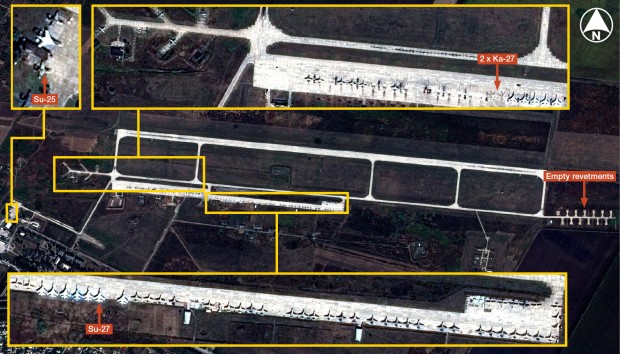
Primorsko-Akhtarsk Airbase, March 14. Photo: Airbus Defence and Space
![Primorsko-Akhtarsk Airbase, March 14 [detail]. Photo: Airbus Defence and Space](https://www.interpretermag.com/wp-content/uploads/sites/5/2014/04/140409-Primorsko-Akhtarsk-Airbase-2-620x429.jpg)
Primorsko-Akhtarsk Airbase, March 14 [detail]. Photo: Airbus Defence and Space
Jane’s IHS, also using Pléiades images, further illustrated the escalation of force by publishing a sequence of photos of a military base north of Belgorod, showing a massive increase in the deployment on-site:
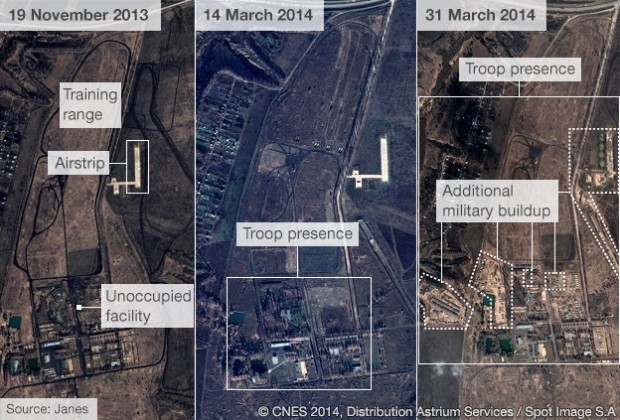
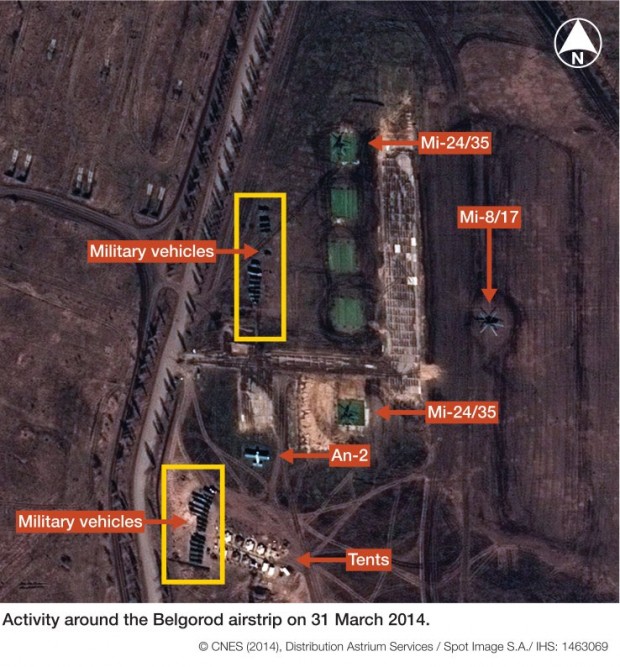
Jane’s comments that:
Airbus Defence and Space imagery captured on 21 March 2014 shows Russian troop formations deployed to a training centre west of Belgorod. As current reporting continues to illuminate Russian military deployments in the region, satellite imagery represents a method of verifying both equipment deployments and deployment locations. Troops deployed to Belgorod reportedly originate from the 76th Air Assault Division in Pskov and the 106th Guards Airborne Division in Tula.
Satellite imagery of the bivouac area at the Belgorod training centre, captured on 21 March 2014, indicates a significant presence of military vehicles consistent with those found in an airborne division. Furthermore, a significant number of tents are present to house personnel.
Additional satellite imagery captured on 31 March 2014 indicates an increased troop presence at Belgorod, including activity around the training centre’s airfield. Photographs of Belgorod initially depicted helicopter activity; while not present in 21 March imagery, 1 x Mi-8/17 ‘Hip’ and 2 x Mi-24/35 ‘Hind’ helicopters are present in 31 March imagery. Also visible are multiple temporary helipads and possible fuel tankers.
On 31 March 2014, IHS Jane’s reported a limited withdrawal of Russian forces from the Ukrainian border region, citing President Putin’s claim that troops deployed near Kadamovsky withdrew from their positions. Increased troop presence at Belgorod indicates the possibility of continued troop build-up in border regions. However, increased deployments at Belgorod, noted in 31 March imagery, possibly transpired prior to Putin’s announcement of a limited withdrawal, with available satellite imagery only able to discern that the build-up took place between 21 and 31 March.
The build-up of forces around Belgorod has already been documented elsewhere with photos on the ground.

Russian helicopters near the Ukrainian border at Belgorod. Photo: Censor.net.ua
In addition to the Pléiades releases, Geoffrey Pyatt, the US ambassador to Ukraine, posted the following photos on Twitter, pointing out a huge build-up of ground forces near Rostov-on-Don, a short distance from the border.
proof of RU military buildup правительство #США опубликовало снимки сил #РФ, сгруппировавшихся у границы с Украиной. pic.twitter.com/5MK1QMHsma
— Geoffrey Pyatt (@GeoffPyatt) April 9, 2014
1310 GMT: Ukrainska Pravda reports that the Ukrainian Security Service (SBU) has announced the arrest of a Russian citizen in Kherson:
The SBU has detained a Russian citizen, who was working for intelligence agencies to destabilise the situation in the southern regions of Ukraine.
Maria Koleda, born in 1991, arrived in Kherson on April 4. She said that this was her ninth trip to Ukraine.
“Between the 5th and 6th of April, the foreigner held several meetings with leaders and activists from the pro-Russian movements in Kherson, and then visited some regional centres in the oblast to monitor the situation on the ground”, says the SBU report.
On April 7, she was directly involved in clashes outside the Mykolaiv Regional Administration, “during which she used firearms, as a result of which, she says she wounded three people”.
Operatives established that on April 8, Koleda reported back to her supervisor in the Russian Federation on the availability to the “activists” of “unlimited quantities” of improvised explosive devices and that an agreement had been reached for them to obtain firearms.
“She also gave an account of the plan for two diversionary groups (7 people from Kherson and 6 from Nova Kakhovka) to be sent to Donetsk to participate in riots”, reported the SBU.
The infiltrator was also supposed to “figure out the stances of Ukrainian Border Service employees on the border between the Autonomous Republic of Crimea and mainland Ukraine, and to ascertain the feasibility of entry from Crimea, either legally or by circumventing checkpoints, of people who had been banned by the SBU from entering Ukraine.
During her arrest, a traumatic pistol, adapted to fire live ammunition, and guidelines for preparing diversionary groups were found on the Russian.
According to Prestupnosti.net Koleda is part of the pro-Putin activist organisation, ‘Rossiya Molodaya’ [Young Russia], the so called ‘Rosmol’.
On social network sites she is friends with the Mykolaiv branch leader of the ‘Russkiy Blok’ [Russian Bloc] party, and with Tatiana Chistyakov, a deputy from the Party of Regions for the Mykolaiv city council.
1255 GMT: Several government buildings in eastern Ukraine remain occupied by pro-Russian separatists, and Ukrainian Interior Minister Arsen Avakov says that this situation will be resolved within 48 hours – either by force or through negotiation. While we’ve already seen Ukrainian forces recapture several buildings without bloodshed or even significant injuries, yesterday we covered reports that the state security building in Lugansk was held by hundreds of gunmen who have, according to the Ukrainian government, set up explosives and are holding at least 60 hostages,
